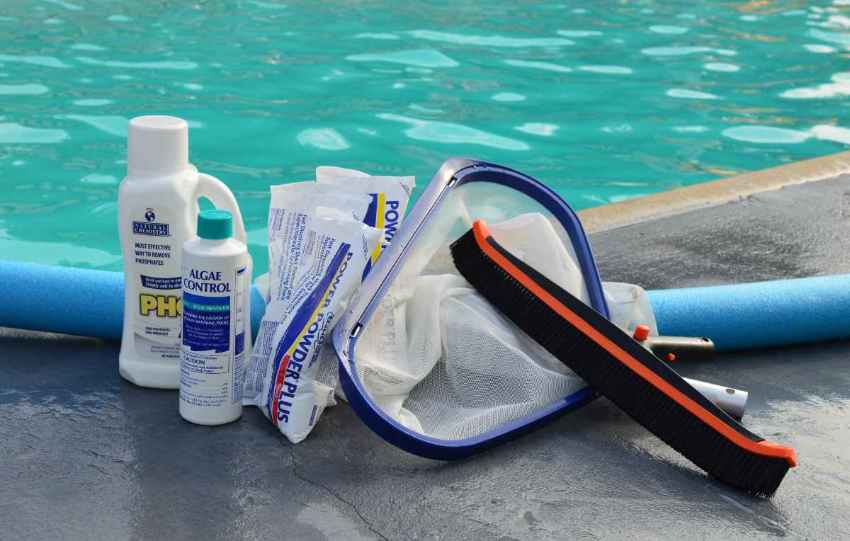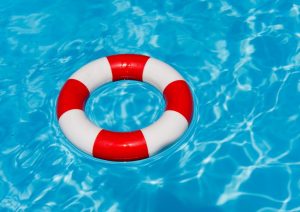
7 Best Swim Snorkels for Better Technique and Faster Swimming
Ready to throw down on a new swimmer’s snorkel? Here are reviews of the best swim snorkels for lap swimming.

Shocking the pool is a key part of running a clean (and usable!) swim pool. Here’s a detailed look at signs you need to shock the pool, how often do it, and steps for doing it like a pro. Clean pool water, engage!
If you’re a new pool owner, you may have heard the term “shocking your pool”.
While it sounds like a bit of a scary term—and no, we aren’t going to run an electric charge through the water—it’s actually fairly straightforward.
Shocking the pool involves using chlorine or other sanitizers to temporarily increase the amount of chlorine, in turn zapping pesky bacteria, algae, breaking apart combined chlorine (which is “used” chlorine), and otherwise sanitizing the water.
Shocking the pool is one of the most effective ways to bring your pool chemicals back into balance and keep your pool nice and sparkling clean.
It’s also something you should do regularly to stay ahead of bacteria and algae buildup.
If you’re confused about when and how you should shock your pool, we have you all taken care of.
In this guide, we’ll cover the usual suspects (symptoms) for when it’s time to shock the pool, how to do it properly, and answer some of your most shocking (ha!) pool shock questions.
Let’s jump in!
You peel back the cover of your above-ground pool, drink in hand, ready to enjoy the pool–and, boom.
Cloudy, greenish, yucky pool water.
In this instance, you know that shocking the pool is in your future.
But there are other less obvious situations where you are going to want to reach for the shock.
They include:
After your pool has been covered for an extended chunk of time or an entire season, and it’s time to open the pool, you should shock your pool.
No matter how well you winterize your above-ground pool, there’s almost guaranteed to be some excess bacteria, cloudy water, and any other unwanted pool guests.
Shocking the water will help get rid of a large part of these unwanted microorganisms and get you on your way to clean, swimmable water again.
Fun fact: people are kinda dirty! The sunscreen, the sweat, the pee, the hair—all of that stuff sheds into the water and eats up free chlorine.
Increased use of the pool means a commensurate increase in bacteria and other contaminants left behind after the last swimmer has toweled off and gone home.
See also: How to Clear Cloudy Pool Water
You’ll likely notice the pool water is a little cloudier than usual after a lot of people have been in and out of the water.
Shocking the pool will increase chlorine levels after heavy use and help sanitize.
When it’s been hot for quite a while, it can cause your pool to also raise in temperature.
Higher temperatures can trigger the growth of bacteria and decrease chlorine efficacy.
Heavy rains can also cause contamination of pool water, increasing pH.
Either way, a shock can help restore balance.
Contrary to what public pools and conventional wisdom will tell you, the smell of really strong chlorine is actually a sign that there’s an increased amount of combined chlorine in your pool.
(Combined chlorine, also known as chloramines, is the byproduct of free chlorine and organic matter coming together and making a smelly lovechild.)
Combined chlorine is what also causes itchy, red eyes and skin.
A pool shock can get rid of that combined chlorine/chloramines while offering higher free chlorine levels.
If you notice algae growing in your pool, the best way to combat it is by significantly boosting chlorine levels.
Keep in mind that using pool algaecides is also an excellent way to prevent excess algae growth in the first place, but a good pool shock has a role to play here, too.
Before we jump in and start shocking away, it’s important to get a grasp of the basics of what we are shocking the pool with.
First, let’s talk about the different types of chlorine.
When you reach BC, the free chlorine will start to build up.
When shocking a pool, we want that free chlorine to be around 10 times the combined chlorine level, achieving breakpoint chlorination.
One of the things you will get insanely good at being a pool owner is testing and retesting the water.
When shocking the pool, you should test before throwing anything in so that you have a baseline of how much shock to put in.
At this point, pre-shock, the free chlorine level should be lower than the total chlorine level.
What this signifies is that your combined chlorine level isn’t balanced, and needs a shock to regain it.
While you got your handy little pool test strip or digital pool test kit out, may as well check everything else, too!
You also need to be revising pH and alkalinity, as all are incredibly important and affect one another.
pH should be within 7.4 and 7.6, while your alkalinity should be between 100 and 150 ppm.
By ensuring your pH and alkalinity levels are within these ranges, you’re creating the perfect water chemistry to maximize shock treatment efficacy.
Does your pool come with a vinyl or fiberglass liner, like most above-ground pools?
Then calcium hardness should be between 175 and 225 ppm.
If yours is made with concrete or plaster instead, raise that level to between 200 and 275 ppm.
Whichever pool shock you settle on, it’s always recommended that you read the instructions it comes with and shock accordingly.
Most reputable products will come with some kind of chart or step-by-step instructions so you can accurately calculate how much you need.
There’s really not a whole lot of guesswork involved, and after the first couple of times, you should be able to apply it correctly without even needing to refer to the instructions.
Many products will indicate for you to first dissolve the shock in a separate container outside of the pool.
You’ll do that by taking a bucket with about ¾ full of warm water, gently adding the shock to the bucket, and slowly mixing until dissolved.
There are many pool shocks that do not require you to pre-dissolve them.
If that’s the case with the one you’ve chosen, first determine how many containers of shock you need.
We highly recommend taking it slow and adding just a bag/container at a time until you have added the right amount.
As you pour, walk around the perimeter of the pool to help evenly distribute it.
Your pool pump and filter should be operating at full speed for around 10 hours to help better mix in the shock.
And remember to keep the pump and filter running so that water circulates and you don’t bleach the sides of your pool.
Finally, there is a best time to shock your pool, and that’s once the sun goes down.
Start your shock at dusk, so that it processes throughout the night.
Doing so in the daytime will result in the sunlight burning off chlorine, yielding the shock ineffective.
I know we’ve hammered ya with a lot of chlorine talk, but it’s important to remember the difference between stabilized and unstabilized chlorine.
Stabilized chlorine has cyanuric acid (a stabilizer, hence the name) added to it which keeps the chlorine from rapidly degrading from UV exposure.
Unstabilized chlorine is less expensive, but left exposed to the sun will burn off and you’ll watch the cost savings (and your pool chemistry) go up in smoke.
Because safety never takes a holiday, you know?
Beyond not pumping pool shock through your automatic chlorinators—which will damage both the skimmer and accumulate some potentially dangerous gases—here are a couple more best practices for applying pool shock safely and efficiently:
We are talking about pool chemistry and chemicals after all!
Try to face away from the container when breathing in.
It’s even better if you can grab a chemical mask to wear as you’re mixing and pouring the shock.
Breathing in chlorine gas is not a good idea, and can easily cause throat, nose, and lung irritation.
Handle pool chemicals with gloves to reduce skin irritation, as well.
Even if it’s the same brand, just don’t do it unless you want to turn into some kind of Ninja Turtle.
By mixing pool shocks, you could potentially end up creating toxic gases that could even be deadly.
Even mixing liquid chlorine or dry chlorine granules can create volatile chemical reactions.
Again, just follow the instructions on your pool shock, and you’ll do just fine.
Yes, you can shock a pool too much.
If the free chlorine levels are over 5ppm, the water is not safe to swim in. Remember, 1-3ppm is the sweet spot where we want free chlorine to hang out.
If free chlorine is higher than recommended, take the cover off the pool and let the sun hit the water, it will burn off and degrade some of the free chlorine.
Secondly, remove any floating chlorine dispensers that are still pumping product out into the water until the pool chemistry is in balance again.
You should wait at least a full 24 hours or until chlorine levels reach levels of at least 1ppm and no more than 4-5ppm and pH levels are in the range of 7.2 to 7.8.
Chlorine, as amazing of a disinfectant as it is, takes time to circulate through your pool and sanitize the water completely. Monitoring pH will also tell you how ready the pool is for action again.
While the frequency at which you shock your pool depends on various factors (use, environment and weather, etc.), you probably don’t want to shock it every day because you would never be able to use it.
After all, you won’t be able to use your pool until a minimum of 24 hours have passed after you apply the shock.
Outside of the “hot and heavy” special occasions that warrant a special shock, you should only really have to shock the water every two weeks or so with regular use.
Even if you’re using your pool on a daily basis, the recommended shock frequency is every 2 weeks or so.
In order to achieve a clean pool so that you can get the most of it this summer, shocking it regularly and properly is crucial.
But, once you get a hang of testing and shocking the water, you will be able to rest easy, knowing that your pool water is going to be ready for those hot summer afternoons.
Now that you’ve got the grasp of how to shock the pool like a champion, get to it and enjoy that sparkling blue water!
How to Clean an Above Ground Pool (Step-by-Step). Wondering how to get started with cleaning an above-ground pool? Here’s a step-by-step guide to crystal-clear pool water in your above-ground swim pool.
How to Vacuum an Above Ground Pool. Vacuuming your above-ground pool task is a crucial step in maintaining and cleaning your pool and keeping the water crystal clear. Here is how to do it right the first time.
Subscribe to the YourSwimLog.com newsletter and get tips and advice on how to swim faster every weekday morning, straight to your inbox.
Join 33,000+ swimmers, coaches, and swim parents learning what it takes to swim like a boss.
Unsubscribe anytime. Email will never be shared or sold.

Olivier Poirier-Leroy Olivier Poirier-Leroy is the founder of YourSwimLog.com. He is an author, former national level swimmer, two-time Olympic Trials qualifier, and swim coach.

Ready to throw down on a new swimmer’s snorkel? Here are reviews of the best swim snorkels for lap swimming.

Looking to get some new swim gear on a budget? Shop the best Black Friday deals for swimmers in this exclusive guide.

Looking for the best swimming app to maximize your time and effort in the water? Here’s a look at the top swim apps for conquering your swim workouts.

Wondering how often you should be testing the water in your pool or spa? Here’s a detailed look at how frequently you should test your pool. Your swimming pool and spa relies on being properly balanced to keep the water clean and safe for swimming. As a pool owner, you

Fed up with the effects and smell of chlorine in your hair after swimming? Here is how to remove chlorine from your hair once and for all.

The DMC Elite fins are high-performance training fins for competitive swimmers. Here’s a review of why these fins are flat-out awesome.

LANE 6 PUBLISHING © 2012-2024 · PRIVACY POLICY · RETURN POLICY · TERMS OF SERVICE · AFFILIATE DISCLOSURE